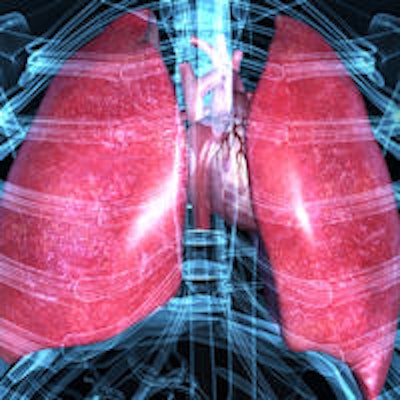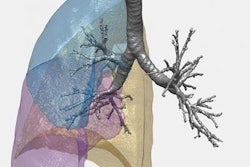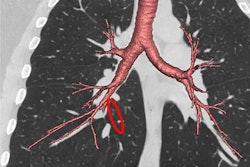
A new analysis of patients who participated in the National Lung Screening Trial (NLST) shows a clear relationship between the severity of chronic obstructive pulmonary disease (COPD) and lung cancer incidence at screening. The findings suggest that COPD patients should be included in CT lung screening programs.
Investigators from the University of Auckland in New Zealand, in cooperation with NLST investigators in the U.S., looked at a subgroup of nearly 19,000 individuals from the NLST. They found lung cancer incidence that was more than 100% higher in individuals with stage III-IV airflow obstruction on the Global Initiative for Chronic Obstructive Lung Disease (GOLD) scale, compared with patients who had normal lung function.
"We found there was a relative increase in GOLD grade corresponding to the incidence of lung cancer," said co-author Raewyn Hopkins from the University of Auckland. Hopkins presented the results in May at the American Thoracic Society (ATS) meeting in San Francisco.
Known association
Epidemiological studies have consistently shown that COPD is associated with an increased risk of lung cancer among smokers. But conflicting results have fueled debate over how closely lung cancer incidence tracks the severity of airflow obstruction: Some studies have found a linear relationship between the two while others have not. A Spanish study, for example, logged a higher incidence of lung cancer among patients with less severe COPD.
 Raewyn Hopkins from the University of Auckland.
Raewyn Hopkins from the University of Auckland.The study by de Torres et al followed 2,507 COPD patients for a minimum of five years and detected 215 cases of lung cancer (American Journal of Respiratory and Critical Care Medicine, October 15, 2011, Vol. 184:8, pp. 913-919). They found that lung cancer risk decreased as the GOLD grade rose; the hazard ratio for lung cancer diagnosis was 3.05 for GOLD stage I, 2.06 for GOLD stage II, and 1.67 for GOLD stage III.
"It's really only GOLD grade 4 where you see a reduction in lung cancers," Hopkins said.
On the other hand, a 2008 study by Wilson et al (Am J Respir Crit Care Med, October 1, 2008, Vol. 178:7, pp. 738-744) found that "the incidence of lung cancer increased with greater airflow obstruction -- with the highest rates in those with the greatest GOLD grade," she said.
The large cohort of NLST subjects offered an opportunity to re-examine the relationship for the present study, according to Hopkins and colleagues. The New Zealand team analyzed a substudy of NLST screening subjects by Young et al in 2015 that was performed by the American College of Radiology Imaging Network (ACRIN) to measure airflow obstruction.
The ACRIN-NLST cohort of 18,714 screening subjects included 6,436 participants (35%) with airflow limitation (COPD) according to baseline spirometry. They were followed for a mean of 6.4 years, with 768 lung cancer cases diagnosed. The COPD patients were grouped as GOLD stage I, II, III, or IV.
Toward clarity
Patients without airflow limitation (n = 12,039) had a lung cancer incidence of 4.63 per 1,000 person-years; in comparison, rates were higher in those with airflow obstruction:
- 7.58/1,000 for GOLD I
- 9.43/1,000 for GOLD II
- 12.7/1,000 for GOLD III
- 15.55/1,000 for GOLD IV
| Lung cancer cases by severity of airflow limitation | ||
| Severity of airflow limitation | Total cohort (100%)* | Lung cancer cases |
| No limitation | 12,039 (46.5%) | 357 (+0%) |
| GOLD I | 1,607 (8.6%) | 78 (+19%) |
| GOLD II | 3,528 (18.9%) | 213 (+47%) |
| GOLD III-IV | 1,294 (6.9%) | 109 (+106%) |
"We found a relative increase in GOLD grade in the incidence of lung cancer," Hopkins said.
Lung cancer histology also differed significantly between the categories, with more squamous and non-small cell lung cancers in patients with COPD, and more adenocarcinomas and bronchioalveolar carcinomas in those without airflow limitations (p < 0.004).
"We think that the severity of airflow limitation has a linear relationship with increasing risk of lung cancer, and that's what we've shown in this NLST-ACRIN study," Hopkins said.
The results are replicated in a sensitivity analysis of the data and also in other studies of both screened and nonscreened populations, she added.
The apparent contradiction with the Spanish results may reflect the presence of more severe emphysema in symptomatic GOLD grade I and II airflow limitations, Hopkins said.
As for whom to screen for lung cancer considering the greater risk in COPD patients -- half with airflow limitation and half without -- Hopkins said better targeting of screening will require addressing the high rate of underdiagnosis.
"We think that knowing the COPD status or the airflow limitation status is a beginning in the process of screening and maximizing our screening population," she said in response to a question from the audience at ATS 2016. "We know that most patients with COPD remain undiagnosed -- the degree of undiagnosed COPD is upward of 60% to 80%, and is usually found in population studies."




















